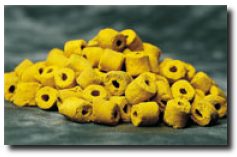MECS Engineered Sulfuric Acid Catalyst
The vanadium- based catalyst is an extremely important “cog” in the many sulfuric acid technologies provided by MECS. The sulfuric acid catalyst is used to catalyze the oxidation of sulfur dioxide (expressed below)
The sulfur trioxide (SO3) is then reacted with water to form sulfuric acid (H2SO4). The main components of the MECS catalyst include: SiO2 (silica; as a support), vanadium (V), potassium (K) and/or cesium (Cs), and various other additives. The reaction shown above actually occurs within a molten salt consisting of potassium/cesium sulfates and vanadium sulfates, coated on the solid silica support. This unique catalyst has proven to be very stable and long-lived in the sulfuric acid production industry. Because of the unique chemistry of this molten salt system, the vanadium is present as a complex sulfated salt mixture and NOT as vanadium pentoxide (V2O5). Therefore, the catalyst is more correctly called a “vanadium-containing” catalyst rather than the commonly-used “vanadium pentoxide” catalyst. MECS provides a wide variety of sulfuric acid catalyst products.
Conventional Catalyst: The LP-110/T-11 catalysts were designed for the lower bed environment (low SO2, low O2, possibly high SO3, slow reaction rates) to provide the highest catalytic activity level while maintaining ring/pellet integrity. Several beds of these high activity catalyst are still in service after 25 years. Vacuum screening losses for these catalysts generally range from 10-12%; manual screening losses are usually 5% or less.
|
Sulfuric Acid Catalystadmin2017-05-18T03:34:50+00:00

 MECS has been manufacturing and marketing sulfuric acid catalyst since 1925. The catalyst is sold worldwide and MECS provides high quality technical and commercial support before and after the sale.
MECS has been manufacturing and marketing sulfuric acid catalyst since 1925. The catalyst is sold worldwide and MECS provides high quality technical and commercial support before and after the sale.